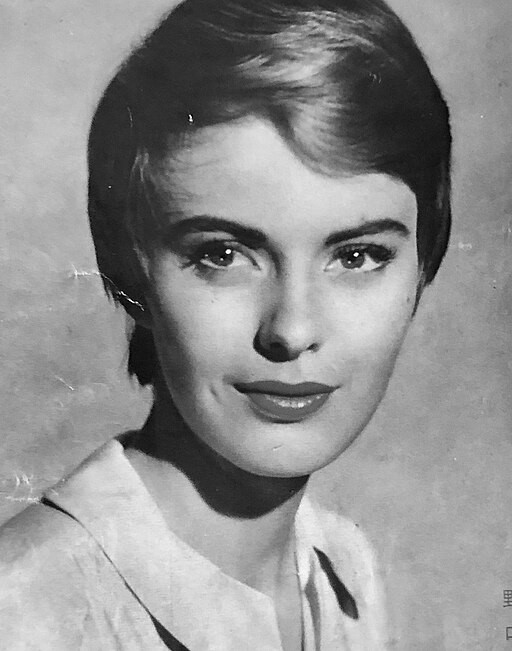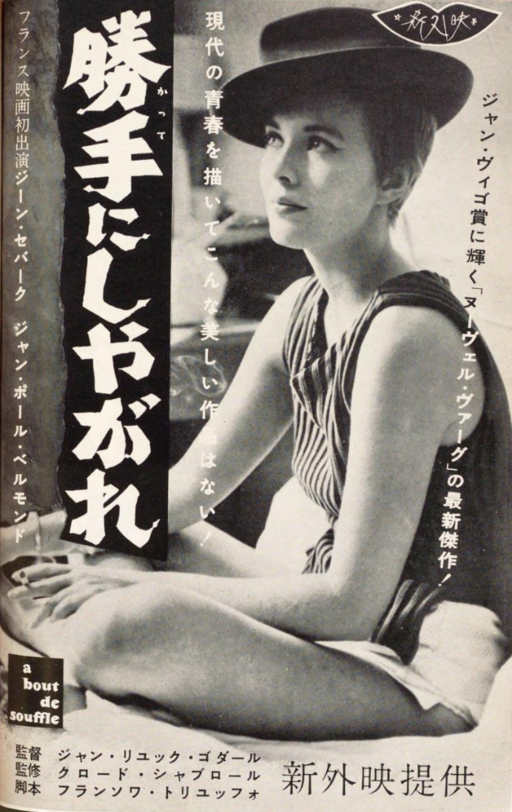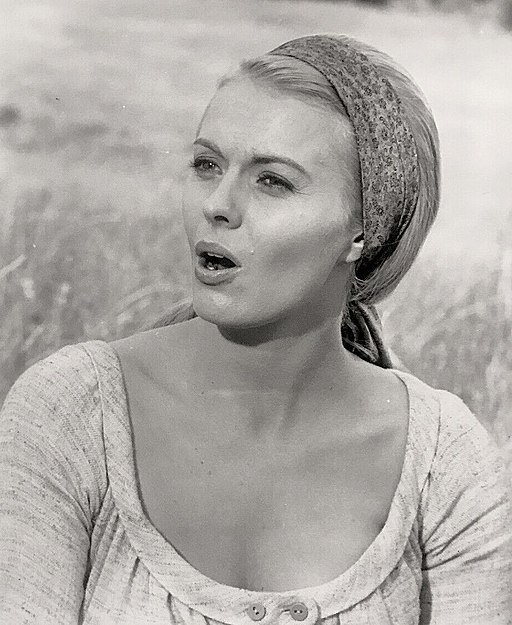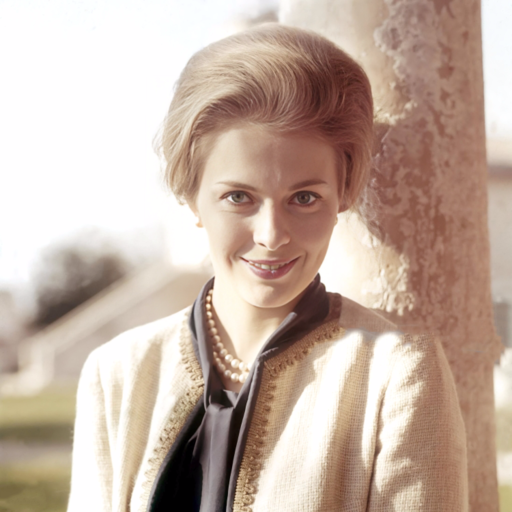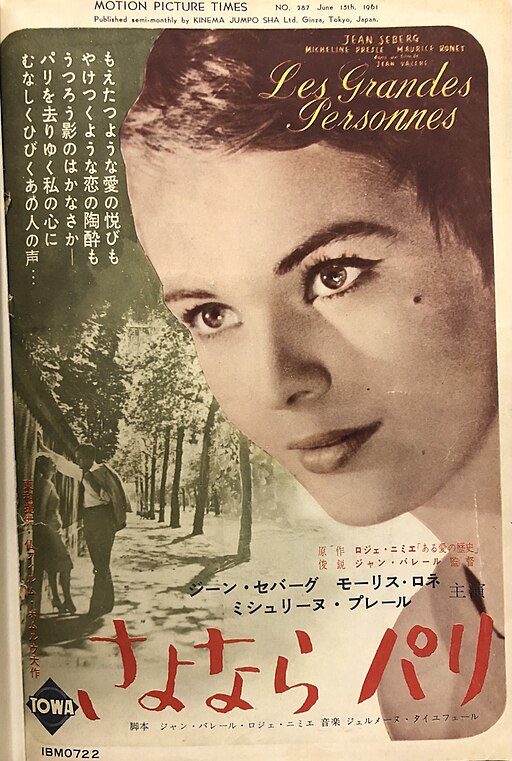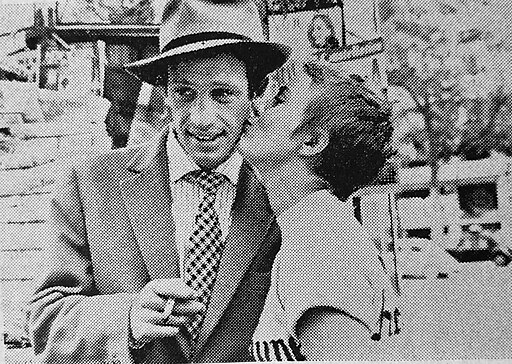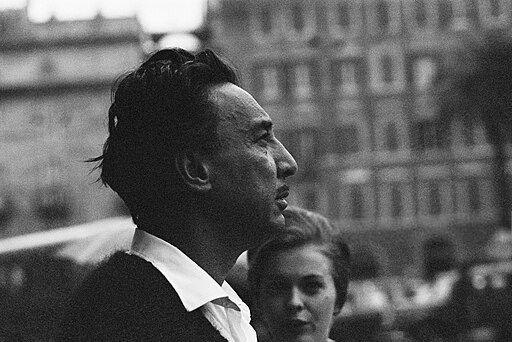Jean Seberg
back| Full Name | Jean Dorothy Seberg |
| Stage Name | Jean Seberg |
| Born | November 13, 1938 |
| Birthplace | Marshalltown, Iowa, USA |
| Died | August 30, 1979 |
| Buried | Montparnasse Cemetery, Paris, France |
| Married to | François Moreuil (1958–1960), Romain Gary (1962–1970), Dennis Berry (1972–1979, her death) |
| Children | Alexandre Diego Gary, Nina Hart Gary |
| Notable films | Saint Joan (1957) - Breathless - A Bout de Souffle (1960) - Bonjour Tristesse (1958) - |
Jean Seberg
Icon of modernity, independence and rebellion
Jean Seberg, born on November 13, 1938, in Marshalltown, Iowa, rose to international fame as a symbol of the French New Wave cinema. Discovered at age 17 by director Otto Preminger, she debuted in "Saint Joan" (1957), but it was her role in Jean-Luc Godard's "Breathless" (1960) that cemented her place in film history. Her portrayal of Patricia Franchini, with her iconic pixie cut and New Wave chic, became a style and cultural reference.
Seberg's career was marked by a blend of American and European films, including "Bonjour Tristesse" (1958) and "Lilith" (1964). However, her life off-screen was tumultuous, marred by personal struggles, mental health issues, and political activism. An outspoken supporter of the civil rights movement, she faced harassment from the FBI under J. Edgar Hoover, which took a toll on her personal life.
Tragically, Seberg's life ended prematurely under mysterious circumstances in Paris in 1979. Her death, ruled a probable suicide, was surrounded by speculation and controversy, partly due to her surveillance by the FBI. Despite her brief career, Seberg's impact on cinema endures, remembered for her distinctive acting style and as a tragic figure of the artistic and political turmoil of her time.
Related
Jean Seberg
Biography and analysis of her career
Jean Seberg was an American actress who found fame in both Hollywood and French cinema. She was born in Marshalltown, Iowa, and began her acting career in an unconventional manner when she was chosen from over 18,000 hopefuls in a nationwide talent search by director Otto Preminger for the title role in "Saint Joan" (1957).
Career Highlights
Seberg's performance in "Saint Joan" received mixed reviews, but it launched her career in the film industry.
She gained international recognition with her role in Jean-Luc Godard's French New Wave classic "Breathless" (1960), in which she played Patricia Franchini, a character that became iconic for her pixie haircut and chic style.
Other notable films include "Bonjour Tristesse" (1958), where she played a scheming teenager, and "Lilith" (1964), in which she portrayed a mysterious and troubled patient in a mental hospital.
Personal Life and Activism
Seberg was known for her support of civil rights and various political causes, which led to her being monitored and harassed by the FBI under J. Edgar Hoover.
Her marriages included French filmmaker François Moreuil, novelist Romain Gary, with whom she had a son, and director Dennis Berry.
The Mysterious and Tragic Death of Jean Seberg:
Jean Seberg's death on August 30, 1979, remains a subject of great intrigue and tragedy, tinged with elements of mystery and controversy. She was 40 years old at the time of her passing. Here are the details surrounding her death:
Discovery of Her Body
Seberg's lifeless body was found in the backseat of her Renault car, parked close to her apartment in Paris's 16th arrondissement. She was wrapped in a blanket, and authorities noted that she had been dead for several days before her body was discovered.
Cause of Death
The official cause of death was determined to be an overdose of barbiturates. The large amount of alcohol and drugs found in her system led the Paris police to rule her death as a probable suicide. However, due to the circumstances and her history with the FBI, there was speculation about possible foul play.
Background and Context
Seberg had a history of depression and mental health struggles, exacerbated by personal tragedies, including the loss of her daughter, Nina Hart Gary. Nina, whom she had with her second husband, Romain Gary, died shortly after birth in 1970. This event profoundly affected Seberg and was compounded by the revelation that she had been a target of the FBI's COINTELPRO program, which sought to discredit and surveil her because of her support for the Black Panther Party and other civil rights causes.
FBI Surveillance and Harassment
The FBI's surveillance and harassment of Seberg were part of a wider effort to discredit activists and public figures involved in civil rights and leftist movements. The agency spread false rumors about the paternity of her child, leading to immense personal distress and public scrutiny. This harassment significantly impacted Seberg's mental health and personal life.
Aftermath and Romain Gary's Statements
Following her death, Seberg's ex-husband Romain Gary held a press conference where he blamed the FBI's campaign against Seberg for her deteriorating mental health and ultimate demise. He criticized the media and the FBI for their roles in her tragedy.
Legacy and Remembrance
Jean Seberg's death is often remembered as a tragic end to the life of a talented actress and a passionate civil rights supporter. Her experience highlighted the dangers of government overreach and the vulnerability of public figures to such actions. Seberg is remembered not only for her contributions to cinema but also as a symbol of the tumultuous era in which she lived and the personal costs of political involvement.
In summary, Jean Seberg's death was the culmination of a series of personal tragedies and external pressures that deeply affected her life and mental health. Her story remains a poignant reminder of the impact of political persecution and the fragility of individuals in the public eye.
Notable Movies featuring Jean Seberg:
1957:
- "Saint Joan": Directed by Otto Preminger, this film adaptation of George Bernard Shaw's play features Seberg as Joan of Arc, depicting the life and eventual martyrdom of the French heroine.
1958:
- "Bonjour Tristesse": In this Otto Preminger film, Seberg plays Cécile, a carefree teenager whose life is turned upside down by her father's decision to remarry.
1959:
- "The Mouse That Roared": A satirical comedy where Seberg plays Helen Kokintz, a scientist's daughter involved in a plot by a small European duchy to declare war on the United States.
1960:
- "Breathless" (À bout de souffle): Directed by Jean-Luc Godard, this French New Wave classic features Seberg as Patricia Franchini, an American student and aspiring journalist who becomes involved with a petty criminal in Paris.
1961:
- "Time Out for Love" (Les Grandes Personnes): Seberg stars as Ann, a young woman on holiday in Spain, caught in a love triangle.
1964:
- "Lilith": Seberg plays the title character, a mysterious and enchanting patient in a mental hospital, captivating the attention of a new employee played by Warren Beatty.
1965:
- "Moment to Moment": A psychological thriller where Seberg portrays Kay Stanton, a woman who accidentally kills her lover.
1966:
- "A Fine Madness": Seberg plays Rhoda Shillitoe, the frustrated wife of an eccentric poet in this comedy-drama.
1967:
- "The Road to Corinth" (La route de Corinthe): A spy thriller with Seberg as Shanny, an agent investigating a mysterious death in Greece.
1969:
- "Paint Your Wagon": In this musical western, Seberg plays Elizabeth, a woman in a ménage à trois with two gold miners.
1970:
- "Airport": A disaster film where Seberg portrays Tanya Livingston, a chief stewardess, in one of her most commercially successful roles.
1972:
- "Kill!": A crime thriller with Seberg as Emily Hamilton, a woman caught in a web of intrigue.
1974:
- "Mousey" (TV Movie): Seberg plays Laura Anderson, the estranged wife of a biology teacher seeking revenge.
1975:
- "Diamonds" (aka "The Great Diamond Robbery"): In this crime comedy, Seberg is Lisa, involved in a plot to steal a large diamond collection.
1976:
- "The Wild Duck": An adaptation of Henrik Ibsen's play, where Seberg plays Gina Ekdal, dealing with family drama and secrets.
Analysis of the acting style of Jean Seberg:
Jean Seberg's acting style was notable for its blend of naturalism and nuanced expressiveness, which made her a standout figure, particularly in the French New Wave cinema. Her style was marked by several key characteristics:
Understated Naturalism
Seberg was known for her understated and naturalistic approach to acting. Unlike the melodramatic style that was prevalent in Hollywood at the time, her performances were more subdued and realistic. This quality made her a perfect fit for the French New Wave, which sought to break away from conventional filmmaking.
Expressive Minimalism
She had a remarkable ability to convey emotions subtly and with minimalistic expressions. Her performances were often nuanced, with a lot conveyed through small gestures, facial expressions, or a certain look in her eyes. This minimalist approach allowed her to portray a range of emotions effectively without over-dramatization.
On-screen Confidence and Poise
Despite her young age when she rose to fame, Seberg exuded a sense of confidence and poise on screen. She had a distinctive screen presence that combined vulnerability with a kind of self-assuredness, making her characters both compelling and relatable.
Versatility
Seberg's roles varied from the complex and troubled characters in films like "Lilith" to the iconic, breezy American in Paris in "Breathless." Her ability to navigate different genres and characters showcased her versatility as an actress.
Charm and Charisma
Seberg had a natural charm and charisma that shone through in her performances. Her portrayal of Patricia in "Breathless" exemplifies this, where her charisma played a pivotal role in defining the character's appeal.
Modern Woman Portrayal
Seberg often portrayed characters that were emblematic of the modern woman – independent, intelligent, and complex. Her roles frequently challenged traditional female stereotypes, making her an icon of progressive femininity in cinema.
In summary, Jean Seberg's acting style was characterized by its naturalism, subtlety, and expressiveness. She brought a fresh perspective to her roles, embodying the spirit of the French New Wave and influencing the direction of modern film acting. Her legacy in cinema is defined by her distinctive approach to acting, which continues to be celebrated for its impact and originality.
Remarkable quotes from Jean Seberg:
On Acting:
- "Acting in movies is like being in a Kafka situation. You're in a room with no doors, and you scream."
On Personal Identity:
- "I am basically a cocotte, a courtesan, but one who is searching for a new form of expression."
On Film and Life:
- "Film as dream, film as music. No art passes our conscience in the way film does, and goes directly to our feelings, deep down into the dark rooms of our souls."
On Her Career Choices:
- "I never do anything by chance."
On Her Image:
- "I have the strange feeling that I'm not 'me' anymore. It's hard to put it into words, but I guess it's like I was fast asleep, and someone came, disassembled me, and hurriedly put me back together again. That sort of feeling."
Reflecting on Stardom:
- "To be a star is to own the world and all the people in it. After a taste of stardom, everything else is poverty."
On Personal Struggles:
- "Hollywood chewed me up and spat me out. I was completely used up and had nothing more to give."
Awards and Nominations for Jean Seberg:
Despite her significant impact on film, especially within the French New Wave, and her memorable performances, Jean Seberg's career was not marked by a long list of awards and nominations, particularly by major award-giving bodies like the Academy Awards or the Golden Globes. This can be attributed to several factors, including the nature of the films she starred in, which were often avant-garde or outside the mainstream Hollywood productions typically recognized by major award ceremonies.
However, her contributions to cinema, particularly her iconic role in "Breathless" (À bout de souffle), directed by Jean-Luc Godard, have been widely acknowledged and celebrated within the film community and by cinema historians and enthusiasts. "Breathless" remains a seminal work in the film history, and Seberg's performance in it is often cited for its influence and significance.
In terms of recognition, while she may not have received a plethora of awards, Seberg's legacy in cinema is secure. She is remembered for her distinct style, her contributions to the French New Wave, and for paving the way for future generations of actresses in non-traditional, strong female roles. Her impact transcends conventional awards and continues to be felt in the appreciation of her work by audiences and critics alike.
Analysis of her performance in the movie “Breathless” (“A Bout de Souffle”):
Jean Seberg's performance in "Breathless" ("À bout de souffle"), directed by Jean-Luc Godard in 1960, stands as a defining moment in her career and a seminal example of the French New Wave cinema. Her portrayal of Patricia Franchini, a young American woman in Paris, showcased a unique acting style that perfectly complemented the film's innovative approach.
Naturalism and Effortlessness
Seberg's portrayal of Patricia is marked by a naturalism and effortlessness that was groundbreaking at the time. Her casual demeanor and spontaneous reactions contributed to the film's realistic and improvised feel. This naturalistic approach aligned with the French New Wave's departure from conventional, polished filmmaking techniques.
Iconic Visual Style
Seberg's pixie haircut and simple yet stylish wardrobe in the film became iconic, influencing fashion and popular culture. Her look in "Breathless" was more than just a style statement; it reflected the modern, independent spirit of her character.
Subtle Complexity
Seberg brought a subtle complexity to Patricia. Her character is not just a love interest; she is independent, enigmatic, and somewhat inscrutable. Seberg's performance is layered, with moments of vulnerability, nonchalance, and inner conflict. Her portrayal captured the essence of a young woman grappling with her desires, loyalties, and sense of self.
Chemistry with Co-Star
Seberg's chemistry with Jean-Paul Belmondo, who played the lead male character Michel, added depth to their on-screen relationship. The dynamic between Patricia and Michel was central to the film's narrative, and Seberg's interactions with Belmondo ranged from playful and flirtatious to tense and conflicted, adding to the film's emotional complexity.
Contribution to the French New Wave
In "Breathless," Seberg's performance epitomized the French New Wave's break from traditional acting methods. She contributed to the film's fresh and unconventional feel, which was characterized by jump cuts, natural lighting, on-location shooting, and the use of direct sound.
In summary, Jean Seberg's performance in "Breathless" is a key example of the French New Wave's innovative approach to cinema. Her portrayal of Patricia Franchini is memorable for its naturalistic style, visual impact, and the complex portrayal of a young woman's navigating life and love in Paris. Seberg's work in the film remains influential in the realms of cinema and fashion, and it continues to be celebrated for its freshness and authenticity.
Full list of movies with Jean Seberg:
1957:
- Saint Joan
1958:
- Bonjour Tristesse
1959:
- The Mouse That Roared
1960:
- Breathless (À bout de souffle)
- Let No Man Write My Epitaph
1961:
- Time Out for Love (Les Grandes Personnes)
1962:
- Five Day Lover (L'amant de cinq jours)
- In the French Style
1963:
- Congo Vivo
1964:
- Lilith
1965:
- Moment to Moment
- A Young World (Un monde nouveau)
- Diamonds Are Brittle (Les tribulations d'un Chinois en Chine)
1966:
- Line of Demarcation (La Ligne de démarcation)
- A Fine Madness
1967:
- The Road to Corinth (La route de Corinthe)
1968:
- Birds in Peru (Les Oiseaux vont mourir au Pérou)
1969:
- Paint Your Wagon
1970:
- Airport
- Macho Callahan
1971:
- Pendulum (courtroom scenes only, uncredited)
- Ondata di calore
1972:
- Kill!
1973:
- Questa specie d'amore
1974:
- Mousey (TV Movie)
- Camorra
1975:
- Diamonds (aka The Great Diamond Robbery)
- Ballad for Billy the Kid (Ballade pour Billy the Kid, TV Movie)
1976:
- The Wild Duck
- The Big Delirium (Le Grand Délire)
1979:
- The Blood of Others (Le sang des autres, released posthumously in 1984)

